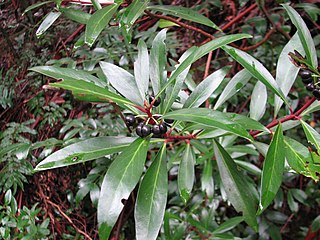
Tasmannia is a genus of woody, evergreen flowering plants of the family Winteraceae. The 40 species of Tasmannia are native to Australia, New Guinea, Sulawesi, Borneo, and the Philippines. The Winteraceae are magnoliids, and are associated with the humid Antarctic flora of the Southern Hemisphere. The members of the family generally have aromatic bark and leaves, and some are used to extract essential oils. The peppery-flavored fruits and leaves of this genus are increasingly used as a condiment in Australia. The peppery flavour can be attributed to polygodial.

Joseph Henry Maiden was a botanist who made a major contribution to knowledge of the Australian flora, especially the genus Eucalyptus. This botanist is denoted by the author abbreviation Maiden when citing a botanical name.

Baeckea is a genus of flowering plants in the myrtle family, Myrtaceae, all but one endemic to Australia. Plants in the genus Baeckea are shrubs or small trees with leaves arranged in opposite pairs, white to deep pink flowers with five sepals and five petals, and five to fifteen stamens that are shorter than the petals.

Blandfordia, commonly known as Christmas bells, is a genus of four species of flowering plants native to eastern Australia. Christmas bells are tufted, perennial herbs with narrow, linear leaves and up to twenty large, drooping, cylindrical or bell-shaped flowers.
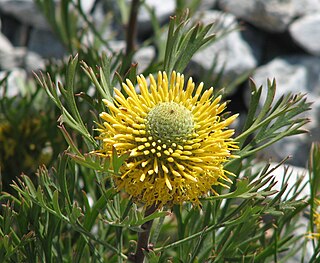
Isopogon anemonifolius, commonly known as broad-leaved drumsticks, is a shrub of the family Proteaceae that is native only to eastern New South Wales in Australia. It occurs naturally in woodland, open forest, and heathland on sandstone soils. I. anemonifolius usually ranges between one and two metres in height, and is generally smaller in exposed heathland. Its leaves are divided and narrow, though broader than those of the related Isopogon anethifolius, and have a purplish tinge during the cooler months. The yellow flowers appear during late spring or early summer and are displayed prominently. They are followed by round grey cones, which give the plant its common name drumsticks. The small hairy seeds are found in the old flower parts.

Lambertia is a genus of flowering plants, belonging to the family Proteaceae. It is endemic to Australia. The genus was named in 1798 by Sir James Edward Smith in honour of English botanist Aylmer Bourke Lambert.

Eremophila denticulata, also known as toothed eremophila, toothed poverty bush and Fitzgerald eremophila, is a flowering plant in the figwort family, Scrophulariaceae and is endemic to the south-west of Western Australia. It is an erect shrub with red flowers and leaves that have toothed margins.
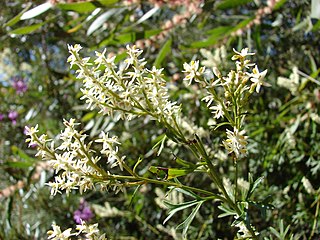
Symphionema is a genus of two species of small shrubs in the family Proteaceae. Both species are endemic to New South Wales in Australia.

Aphanopetalum is a genus of twining shrubs or vines in the family Aphanopetalaceae which are endemic to Australia.

Lambertia formosa, commonly known as mountain devil, is a shrub of the family Proteaceae, endemic to New South Wales, Australia. First described in 1798 by English botanist James Edward Smith, it is the type species of the small genus Lambertia. It is generally found in heathland or open forest, growing in sandstone-based soils. It grows as a multistemmed shrub to around 2 m (7 ft) with a woody base known as a lignotuber, from which it regrows after bushfire. It has stiff narrow leaves, and the pink to red flowerheads, made up of seven individual tubular flowers, generally appear in spring and summer. It gains its common name from the horned woody follicles, which were used to make small devil-figures.
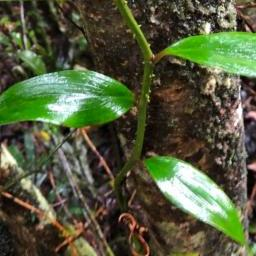
Petermannia is the sole genus of plants in the family Petermanniaceae. Petermannia cirrosa, the only species in the genus, is endemic to the states of New South Wales and Queensland in Australia. it is a prickly, wiry stemmed vine which grows to 6 metres in height and has lancelote, ovate or elliptic leaves with an acute apex. The flowers, which appear during summer, have reflexed reddish green or white tepals. These are followed by rounded red berries.

Chamelaucieae is a tribe of flowering plants within the family Myrtaceae, mostly from Australia, with a few species in New Caledonia and south-east Asia.

Telopea aspera, commonly known as Gibraltar Range waratah, is a plant in the family Proteaceae. It grows as a woody shrub to 3 metres (10 ft) high with leathery rough leaves and bright red flower heads known as inflorescences—each composed of hundreds of individual flowers. It is endemic to the New England region in New South Wales in Australia. It was formally described as a species by botanists Peter Weston and Mike Crisp in 1995, separated from its close relative Telopea speciosissima by its rough foliage and preference for dryer habitat. Unlike its better known relative, Telopea aspera has rarely been cultivated.

Grevillea shiressii is an Australian shrub of the family Proteaceae endemic to New South Wales, where it is found in only two localities near Gosford.
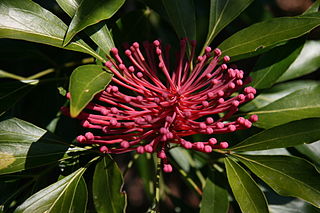
Alloxylon pinnatum, known as Dorrigo waratah, is a tree of the family Proteaceae found in warm-temperate rainforest of south-east Queensland and northern New South Wales in eastern Australia. It has shiny green leaves that are either pinnate (lobed) and up to 30 cm (12 in) long, or lanceolate (spear-shaped) and up to 15 cm (5.9 in) long. The prominent pinkish-red flower heads, known as inflorescences, appear in spring and summer; these are made up of 50 to 140 individual flowers arranged in corymb or raceme. These are followed by rectangular woody seed pods, which bear two rows of winged seeds.

Lomatia myricoides, commonly known as the river lomatia, is a shrub native to New South Wales and Victoria in southeastern Australia.

Persoonia muelleri, commonly known as Mueller’s geebung, is a shrub endemic to Tasmania. It forms a shrub in open areas of wet forests in the west and northeast of the state. It is occasionally confused with P. gunnii though it has larger flowers and longer, straighter leaves.
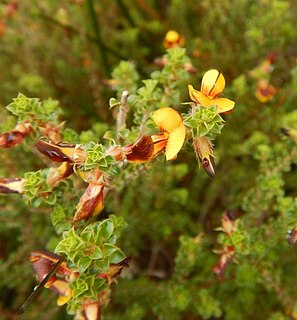
Pultenaea densifolia, commonly known as dense-leaved bush-pea, is a species of flowering plant in the family Fabaceae and is endemic to southern continental Australia. It is a spreading or low-lying shrub with broadly egg-shaped, down-curved leaves and clusters of purple or yellow, red and purple flowers.

Eremophila densifolia is a flowering plant in the figwort family, Scrophulariaceae and is endemic to the south-west of Western Australia. It is usually a low, spreading shrub with densely clustered leaves and lilac to purple flowers.
Wahlenbergia densifolia, commonly known as the fairy bluebell, is a small herbaceous plant in the family Campanulaceae native to eastern Australia.



















